Project & Format by
Enrico Aidala
Editing & Additional Opinions by
Crutch Williams
Images
Plate Name
There are found on the selvage of
some Train notes printed names. These names
were typically drawn
(engraved) on the working lithographic stone plate along
the center line of a sheet to the right of the left four
notes (Aa-Ad)
and/or to the left of
the right four notes (Ae-Ah
). Only two notes
on a sheet could have a name in the margin such as the
right margin of an Ab; or, in the left margin of an
Af plate position. These names were most
often trimmed off when the sheet of notes was cut
apart. Sometimes you can see a partial name; but
only once in awhile will you come across an entire
name. Notes with complete names provide collectors
with yet one more way to collect these 730 Interest
Hundreds that we call Trains.
Whose Name
Who was
this person whose name is found on these note. We
don't actually know the answer to this question.
Over the years these names have been referred to as the
Engraver, Transferer or Printer of the sheet
of notes. It may be any one of those; or, another
term may be more fitting.
Any person creating, transferring, editing or repairing a lithographic design was described in very general terms as an Engraver. When most people think of an engraver, they think of someone who cuts designs into metal plate which is known as recess engraving. During this period in time, this term was also used for the creation of lithographic (surface) and woodcut (relief) designs as well. The individual whose name is found on notes may be described in general terms as an Engraver. An Engraver may be an Artist who worked with portraits or an Architect who worked with buildings. He may be a Practical Engraver specializing in letters, numbers or geometric designs. Each specialty could be further divided into Master Craftsmen, Journeymen and Apprentice for each division. We are of the opinion we should be looking for a more specific term for these names.
Any person creating, transferring, editing or repairing a lithographic design was described in very general terms as an Engraver. When most people think of an engraver, they think of someone who cuts designs into metal plate which is known as recess engraving. During this period in time, this term was also used for the creation of lithographic (surface) and woodcut (relief) designs as well. The individual whose name is found on notes may be described in general terms as an Engraver. An Engraver may be an Artist who worked with portraits or an Architect who worked with buildings. He may be a Practical Engraver specializing in letters, numbers or geometric designs. Each specialty could be further divided into Master Craftsmen, Journeymen and Apprentice for each division. We are of the opinion we should be looking for a more specific term for these names.
Transferer
The name
therefore might be that of a Transferer. A Transferer
was a person who could create lithographic working stone
plates by taking transfers of designs from metal, stone or
paper. This person, who laid out transfer stones and/or
created printing stones, would take a pull (copy) from a
master metal or stone plate and/or from a transfer plate
of either medium and lay down the multiple images to make
up the working plate from which a sheet could be
printed. He would make any necessary repairs to the
final working stone before it was used and even after its
use when uneven wear began to show up. Clearly these
names are found only on the working plate and it may be it
was a Transferer whose name we find.
However, there was usually only one man in each shop with
the title Transferer. So that title, while
possible, isn't likely the answer to our question.
Printer
Another
theory is that these names are those of Printers.
There was a need to keep track of work by the Print Houses
as any paper ruined and/or ruled unacceptable for the
intended purpose was charged back against the contractor's
account. In this instance it would be J. T.
Paterson's account since his company was the only one
printing 730 Trains after purchasing Hoyer & Ludwig's
then current contracts. The imprint of J. T.
Paterson and later J. T. Paterson & Company is found
on each individual note. Having an individual name
on a sheet of notes would be a way to account for each
print run by a specific Printer. The ruined
or unacceptable sheets could then be tracked for each
individual printer. Here we encounter another
question when we wonder if there are too few different
names for the large number of pressmen known to be working
in Paterson's House.
Past Opinions
Over the
years, the two most logical explanations for these names
have been Transferer and/or Printer.
Each of these are deficient for one specific reason.
There was, according to Treasury Records, only one full
time transferer employed by each lithographic
concern. We have too many names recorded on
Paterson's 730 notes for these names to be Transferers.
On the other hand, it is our belief that there may be too
few names in our sample for these printed names to
represent pressmen employed by Paterson. Paterson
had a large number of presses running during this period
printing these 730 notes as well as a few other
denominations of circulating notes. Perhaps it could
be the Printer marking his run.
Sub-Contractor
The one
theory put forth only recently is that these names may
represent Sub-Contractors working in Paterson's
shop. Treasury Secretary C. G. Memminger's desired
to work with only a few major print contractors and he
would place the smaller lithographic print contractors
under the control of one of the larger firms such as James
Paterson and Blanton Duncan. There were
sub-contractors working under Hoyer & Ludwig's control
prior to the removal of printing establishments from
Richmond to Columbia. It is therefore a new theory
that these Printed Names may be those of Sub-Contract
Printers. The names were a way of keeping
track of sheets printed by the individual
sub-contractors. There would be no real reason to
keep track of piece workers directly employed by Paterson
to run his presses unless he would deduct ruined sheets
from individual accounts. There would definitely be
a reason to keep track of individual sub-contractors
working under his roof to make sure that they received
credit. I doubt we will ever find an exact answer as
very few printers are named in Treasury Records and most
that are named other than the primary contractors are a
few owners of smaller printing houses.
Final
ThoughtsThere are no known uncut sheets of 730 Train notes. There are uncut sheets of 1864 $5 & $10 notes which were printed lithographic. On those sheets three names are found and in a few instances you can find a printed name on the selvage of a single note. The backs were printed in Blue and the name found on the back is in blue ink. The next printing was the Red tint plate or underprint on the obverse. There is a name in red ink found on the selvage. Last printed was the design in Black ink. A name in black is also found in the margin. There could have been other names printed on these 730 Interest Hundred sheets that we don't know about. Clearly the names should indicate which printer printed the sheet.
We can't say it was a Paterson employed printer who printed 730 Note sheets. It could just as easily have been a smaller business concern that was classified as Sub-Contractor. We can't prove it was the Printer himself who wrote his name on his plate; or the Transferer who wrote the printer's name in the border for the Printer. In each case we can say in general terms it was done by an Engraver. Therefore it is our opinion that the best term to use for these Printed Names is Plate Name.
Further Study
Examples of individual notes will be added in the future to show exactly where each name is found on the plating. Some Plate Names face outward and some inward. Some are in small letters and others in Caps. We don't know if BEAL and BALE are two different people or the same person who did several print runs. Both spelling come Large & Small on the Plates. One name has two different spelling to make a distinction since the hand drawn names are nearly identical. As more examples show up we will display them.
Known Examples
AMENDT


#25454 Ab Very Small #68886 Ab Caps, dot
BAEL

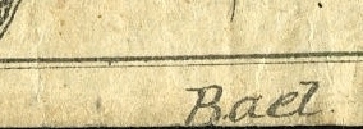
#4312 Ac Lg. Thin Caps, dot #5469 Ac Large with Small, dot
BEAL


#19221 Ab Lg Caps, dot #63038 Ab Small (not sure if dot)
CAMMANN

#18802 Ag Small (only reported)
DABNEY
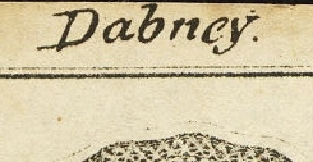
#12647 Ab Small (only reported) dot
DILLMAN
 Recently
Reported on 12 March 2017 to be
Dillman
Recently
Reported on 12 March 2017 to be
Dillman T40 #65219 Aa Small (only reported) We need a better example. Full Image of Obverse
THIEME(R)
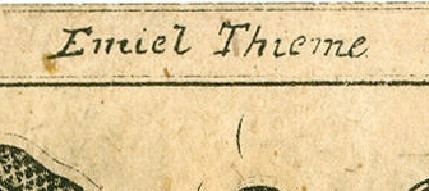
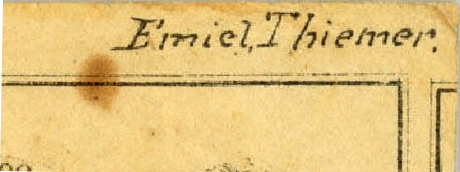
#28837 Ac Small, no R, dot #29335 Af Small, close, comma, dot
HOLLINGS

#63566 Ab Very Small (only reported)
McDONALD
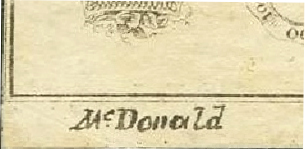
#36962 Ag Small, Heavy Inking s#? Same ?, Light Inking
UNKNOWN ~
Your HELP Appreciated!
If you have a different rendering of any of the names imaged above; or, if you have an unlisted name, please send a full size image at 600dpi of the whole note.
You may send your image to:
Enrico Aidala <enri.ema@tiscali.it> or, Crutch Williams <crutchtm01@hughes.net>